Feature Interview with Jeffrey Stein
December, 2019
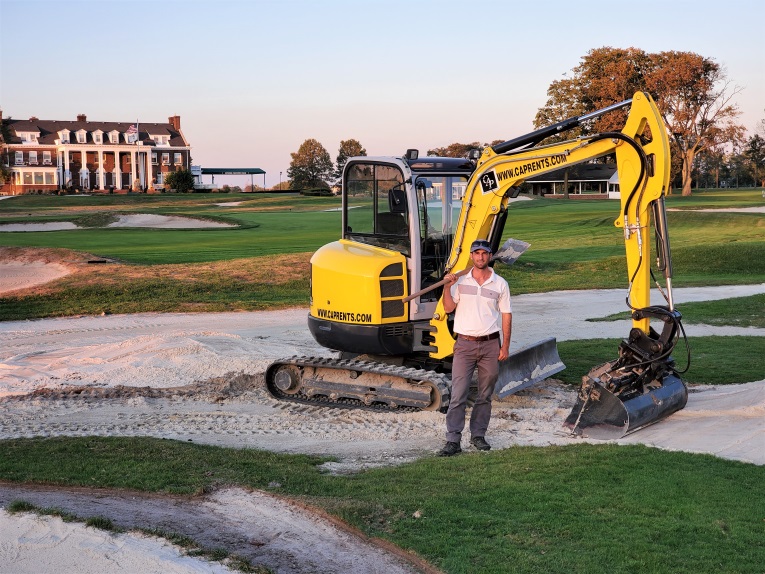
1.How did you become interested in golf course architecture?
My interest took shape early in my childhood and stems from the influence of family, my high school years as a caddie, and a persistent curiosity about golf. As an 8-year-old my brother took me to the golf course for the first time. It just so happened to be–Whippoorwill, a golf course larger than life. On a clear day from the 9th green, you can see midtown Manhattan far in the distance beyond Charles Banks’ spectacular design, laid over a tumbling rocky landscape. If that setting didn’t inspire my young mind, I’m not sure what else could have. Conversely, in the wintertime my father used to take us sledding on that same 9th hole. We spent hours skimming down the fairway shrouded in snow, and I would listen to my brother talk about his experiences on the golf course over the past summer. Ironically, that wintertime activity drove my curiosity about golf courses just as much as walking the course in the summer.
My many summers as a caddie at the Bedford Golf Club through high school and college helped me learn about architecture by spending so much time at just one golf course. With every loop I was internalizing Devereux Emmet’s classic style, born in the roots of the game, while studying golfers’ habits and tendencies. When I wasn’t caddying, on slow summer days I would be practicing my game, preparing for junior tournaments, or getting in my car to find another golf course I had never seen before.
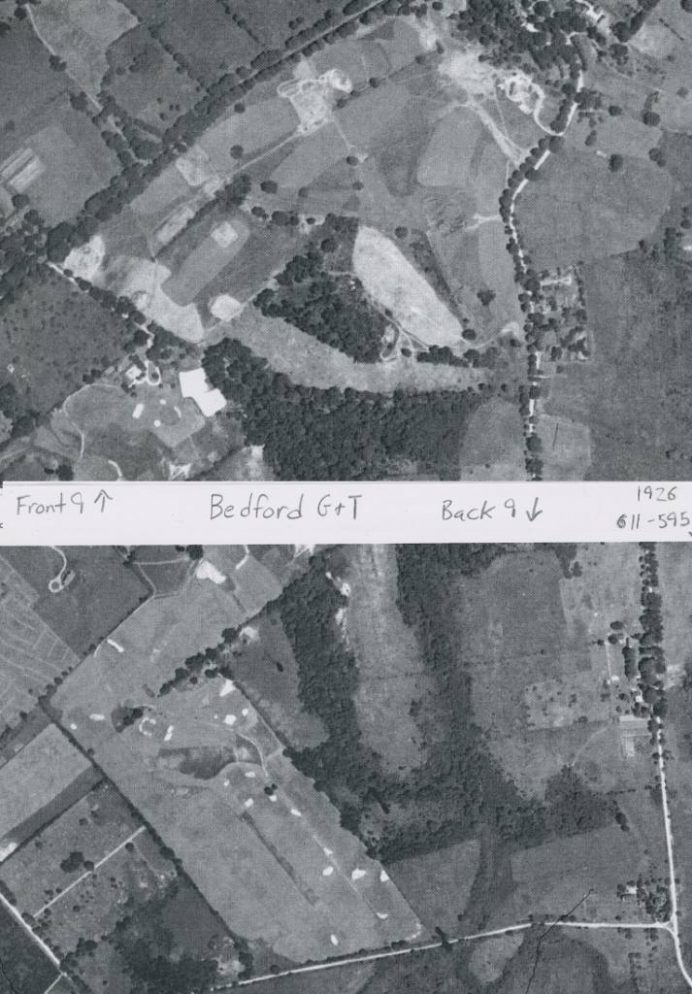
I have always been thrilled by the sensation of discovering an interesting golf course. It’s the type of feeling that compelled me to sleep in my car to play Bethpage Black, or walk up to the line at 4:00am to play The Old Course, or to drive the entire coast of New Zealand’s South Island, looking for the most obscure links. Each time I followed my curiosity to learn more about golf architecture, I was rewarded with unforgettable experiences that have helped me achieve my goals as a design professional.
2. What lessons did you learn about golf architecture through caddying?
In one respect caddying afforded me lots of time to sit and read architecture books while I was waiting for players to arrive. In another respect I’ve learned almost as much about golf strategy from seasoned architects as I have from watching ordinary golfers and listening to their preferences. Golf is an extremely difficult game and most people don’t play or practice very much. As I watched golfers more closely, I realized just how much room they needed off the tee to enjoy the game. This observation translated into a preference for designing wide enough playing corridors and managing peripheral areas so golfers could find their ball and reasonably advance it toward the hole.
Among the trends in golf today, I’m happy to see much more emphasis on width and enjoyment rather than length and difficulty. However, if you ask a golfer (men in particular) if they like hard golf courses, they will likely reply in the affirmative. The real truth is that most golfers actually like golf courses that appear more difficult than they actually are! Obscuring sight lines with the seemingly random placement of hazards at a variety of lengths off the tee and around the green can work to accomplish this very goal.
3. Do you recall a specific ‘a ha’ moment?
The “ah-ha” moment I will never forget occurred as I made my way to the 17th tee at Crystal Downs in Northern Michigan. The topography is tsunami-like and so completely uninviting to a potential golf shot that I didn’t even know one could design a hole like that and get away with it! It felt as if I were staring at a Salvador Dali painting. I ended up being sucked into an alternate reality and couldn’t quite figure out on which club I should hit off the tee. Iron or driver? How hard is the wind blowing off Crystal Lake? Would I rather see the flag on my second shot or take my chances near the green?

Jeff took this picture of the 17th at Crystal Downs in 2008 and the hole’s one-off nature has always stayed with him.
It’s just such a unique and polarizing golf hole and one of my favorites in the world. The whole experience at Crystal Downs just showed me how far Mackenzie could push the envelope of design. After that visit, I realized I wanted to build golf courses like that too.
4. Define great architecture.
The thing about great golf architecture that sometimes gets gets passed over in discussion is the quality of the routing. Great architecture is inextricably tied to a great routing on an exceptional property. One of the best modern examples is the routing of Dismal River Red. There Tom Doak and his associates built some of the most minimally constructed green sites I have personally ever seen. Tom has also notably written on this forum how many architects can miss a tee location, landing area, and/or green location by 20 or 30 yards which can make all the difference in the flow and playability of the golf course. We couldn’t have built those green sites more minimally – and by that I mean strip, till and sand pro – had Tom not unlocked the routing puzzle to perfection.
I asked Renaissance Design associate Brian Slawnik the same question years ago while standing on the back nine at Dismal River Red, as we were getting ready to start construction. All he said was, “You’ll know it when you see it.” I agreed with him at the time, but I also think one can feel it. Great architecture is a heightening of the senses and a calming of the mind. Great architecture is intuitive; it’s the sensation when mind, body, and nature all melt into one. Great architecture can bring people together, create community, and bring a spiritual connection to the ground on which we walk.
5. How did you get into golf course architecture as a profession?
My professional journey into golf architecture began with an introduction to Tom Doak in the fall of 2008. Despite my academic focus in economics and business at Brandeis University, I still knew that I wanted to be a golf architect and applied to Tom’s internship program while I was a senior in college. Although unsuccessful on my first attempt, I was undeterred and took up an offer to meet at his office in Traverse City, MI. I was so excited to make the trip that I took a late flight from New York, connected from Atlanta to Flint, and drove through the night so I could arrive early enough to play High Pointe (Tom’s first solo design)! I arrived before dawn and waited in the parking lot for the sun to come up.
On that day Tom was very gracious about entertaining my curiosity, and even sent me to Crystal Downs later that afternoon. I presented him with a resume of my academic history, athletic achievements in golf, and a portfolio which included landscape photographs and some sculptures I had made from my elective art classes. I never asked, but I have to believe my background stood out from the typical group of landscape architecture applicants he was used to seeing. I’m also sure it didn’t hurt that I was willing to travel to a small town in Northern Michigan just to put a name with a face.
Sometime after the interview and several polite emails and phone calls, Jim Urbina offered me the opportunity to work alongside the Renaissance Design team while they were shaping Old Macdonald at Bandon Dunes Golf Resort (Oregon). In early December 2008, I packed up my station wagon and drove across the country from New York City to begin an exciting career in golf design.
To my surprise, the experience did not begin with sketching golf holes or flagging bunkers with Tom and Jim. After getting oriented, CJ Kreusher, The Old Macdonald Assistant Superintendent, handed me a shovel and bucket and told me to pick rocks on the double wide fairway for holes 3 and 14. Someone had dug a little too deep in the sand pit and scooped pea sized gravel which was not meant for top dressing the fairways. In hindsight what seemed like a menial and endless task taught me a lesson about the process of design and my ability to work with a team. Through that experience, I was quickly able to recognize that there was no job too small in the pursuit of achieving truly great results.
Ken Nice (Bandon Dunes Director of Agronomy) also must have seen how hard I was working and how much I wanted to learn about golf architecture. Both he and Renaissance Golf Design really looked after me during that time, and ensured that I would be able to continue on my path. They gave me another opportunity in 2011 to work on the Bandon Preserve construction, Dismal River Red (where I was named a Renaissance Intern), then later with Jim Urbina on an A.W. Tillinghast restoration at the Paramount Golf Club near my home in NY.
I have so much gratitude toward Tom and his associates for giving me such a tremendous opportunity to learn architecture in the field. Working with Renaissance early on opened so many doors for me, and I certainly would not be as far along as I am today without their support.
6. You have worked for people like Doak, Coore, Hanse, Urbina, Phillips and DeVries at so many of my favorite places including Dismal River (Red), Ohoopee Match Club, Garden City GC, Quaker Ridge, Mid Pines, California Golf Club of San Francisco, Merion, Rockaway Hunting Club, and on and on. Along the way, what have you learned from such mentors?
I’m lucky to say that I consider each one of these talented architects as a mentor. Part of my goal as a professional has been to work with different people and learn a little something from everyone.
- Routing – My most recent and lasting impression on routing a golf course comes from working with Gil Hanse at the Ohoopee Match Club. There, Gil designed two golf courses in one! Like the composite routing at Royal Melbourne or Brookline Country Club, Ohoopee takes the same idea but puts it in miniature form. The alternate route, known as the “whiskey loop” is an 18 hole routing that is significantly shorter than the standard 18 and incorporates 4 alternate holes, designated for afternoon play. The beauty of Ohoopee’s routing innovation is how it is in-tune with golf’s growing focus on fun while still delivering all the strategic intrigue. The big course is no slouch either as it has debuted on the GOLF Magazine World Top 100 list at #98! It was an honor for me to play a role in the construction of the golf course and a big congratulations are due to Gil, Jim Wagner, Rhett Baker (Superintendent) and all the Cavemen.
- Drainage – Mike DeVries understands and works with drainage better than anyone in the business. I know that he would take that as a compliment because it speaks to his attention to detail and willingness to take on challenging problems. I have worked with Mike on several occasions draining artificial ponds, restoring creeks, and wholly improving the surrounding architecture of several golf courses. Just this past Summer Joe Hancock and I assisted Mike in a total redesign of 5 holes at Pelham Country Club, just outside of New York City. We were part of an incredible transformation driven by an urgent need to improve storm water drainage and create irrigation retention for the golf course. Listening to the way Mike thinks through a project everyday is truly a master class and is an experience that can’t be learned anywhere else but in the field.
- Shaping- There are a lot of great shapers out there but few have the ability to create like Jim Wagner, Vice President of Hanse Golf Design. Jim can look at a benign lump of ground and turn it into the most spectacular looking hazard imaginable. He also has the ability to create beautifully refined shapes and lines much of which are inspired by the work of William Flynn from his hometown of Philadelphia. Jim has edited my work countless times, breaking it down, building it back up and pushing for the best possible result. Just when you think you’re done, he taught me to go back and take it to the next level.
- Restoration- Jim Urbina has an uncanny ability to choose restoration projects that seem to exceed everyone’s expectations but his own. He is a true restorer of classic architecture and is not afraid to put his foot down in order to do it right. I have worked with Jim on Mackenzie, Tillinghast, Alison, and Emmet, and no one is better at peeling back the layers to reveal the treasures of golf’s great architects.
7. Tell us some work of which you are particularly proud.
After working at Old Macdonald for nine months in 2009, I spent a year abroad working, golfing, and travelling in New Zealand and Australia. It was an up and down year, as I had to find a lot of odd jobs and had several working opportunities in golf fall through, similar to the state of the economy. The funny thing is the work I’m most proud of has nothing to do with golf. It’s actually the volunteering I sought at the Cardrona Ski Resort in Wanaka, NZ. There, I took to training as an adaptive ski instructor, assisting people with a variety of physical and mental disabilities. I cannot express enough how these experiences have enriched my life, despite what was seemingly a career detour for an aspiring golf architect. Had I not met these wonderful people and their families, I’m not sure I would have gained the same appreciation for my opportunities and the sense of urgency to seize the moment I had before me.
It is my determination, grit and desire to help others that I am most proud. For any young person who wants to get into the golf business, the whole thing is all about hard work and treating people with respect. It’s taken a decade to accumulate these experiences in work and life, and well over 10,000 hours of practice in my craft to be sharing these thoughts with you all. I hope my story is somewhat inspirational to others who wish to follow their dreams as well.
8. 10,000 hours? Good for you for staying in demand! Tell us about your experience working on Bandon Preserve early in your career. What was it like working with Coore & Crenshaw?
I was on-site from the early days of clearing to the last days of hydro-seeding. Throughout the project I assisted Bill Coore, helping him fine tune the finish work on the greens and surrounds. Bill’s eye is as good as any when it comes to the finishing details in the sand and working together meant that I had the opportunity to pick his brain about architecture and ask advice about how to move forward with my career. We spent countless hours shaving the sand, one tenth of foot here, and a tenth of an foot there, just to create the micro contour he wanted to see in the finished product. Working in that wonderful dune setting, overlooking the Pacific Ocean was a dream come true and a unique learning experience. While Dave Zinkand shaped the entire golf course, Bill and Ben put the fine touches on everything. Listening to them converse was at times, both fascinating and hilarious. They would all talk in depth about the shapes and angles of play, while at the same time gently needling one another to see each other’s point of view. I was more of a fly on the wall at that point but could see that there was always a healthy debate happening during the creative process. No one was immune from a good natured ribbing and Bill’s light humor seemed to bring out the best in everyone’s talents.
9. What do you think of 9 hole golf courses? Should we build more of them or just play less golf?
I like 9 hole golf courses and sometimes playing 9 is just the right amount. Sometimes a quick 3 is all you can get after work, before sunset. When I’m really busy working on the golf course, I’ll settle for a few putts. My point is that if we make golf more accessible with options to play shorter sequences, more people will play! However, I’m not convinced we need to build more 9 hole courses as a remedy across the board. It would really depend on the specific market and demand for golf. There are plenty of opportunities to play less golf, it just all depends if your local golf course will let you!
10. Name a few favorite 9-holers.
Hopson Hills – Utica, NY
Hopson Hills is a 9-holer built on an old dairy farm 40 min outside of Utica, NY. With a full time crew of just 2 men, Hopson Hills should be commended for its really good greens, simple, lay of the land character, and dedication to the principles of pure golf. Hopson is a true country course, like those found off the beaten path in Scotland. Only the greens receive sparing irrigation, and you will be more than pleased to watch your ball bound and bounce over the springy fairways. The owner, Bill Fox, is an extraordinary person who decided he wanted to build a golf course by any means necessary. I admire the fact that he saw the project through and managed to create a public amenity that serves the local high school and surrounding community. Hopson could be a case study in proving that inexpensive constructions can also lead to really good golf, if the right property is chosen. For those reasons, I reached out to Bill in 2016 to see if I could get involved with his project. I ended up living on the property in a small house next to the maintenance barn for just over one month, helping him with the final preparations in opening the 9-hole routing for the first time. It was a rewarding experience, and I hope the golf course gets a little more attention in the future.
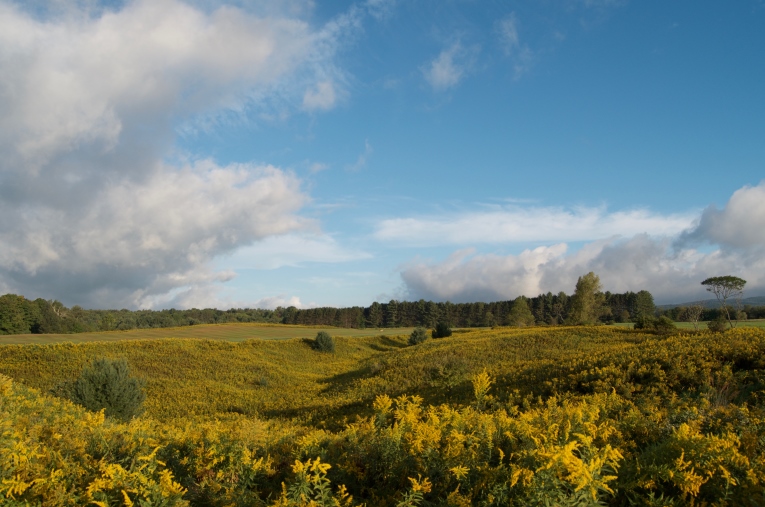
This view from the future 15th green at Hopson Hills captures the property’s wonderful undulations.
Highlands Links- North Truro, MA
Highlands Links is accessible to the public, inexpensive, and should be cherished as living history of early American links golf. It’s a favorite of mine that flies under the radar, but it is truly one of the best golf experiences you can find. The only catch is that you must go nearly all the way out to the tip of Cape Cod to see it. Overlooking the Atlantic Ocean on a high bluff there is a small shack of a pro shop and a traditional cape white lighthouse to guide you. The opening tee shot takes you away from home on a short par 4 nestled among a sea of perfectly sparse golden grasses. What you see is what you get at Highlands Links, a true seaside golf course, preserved in its simplicity, blowing in the wind, hopefully until the end of time.
Mosholu- Bronx, NY
On the other end of the spectrum we have Mosholu in New York City. It is a 2,312-yard tree lined 9-hole course, rated as a par 64! It’s the perfect urban oasis–a flagship for the First Tee Program. I have always enjoyed playing a quick round here and especially look forward to the uphill par 3 Biarritz on the final green.
11. You started Stein Golf Design (www.steingolf.com) in 2011 and you are based in Port Chester, New York. Why and what did you hope to accomplish? What value do you bring to a project?
I decided to base myself in Port Chester, NY because it is well situated in Westchester County with ease of access to places in Northern New Jersey, Long Island, and New England. I grew up close by and it doesn’t hurt to have a little local knowledge when you need to ramp up for a job.
The value that I bring to a given project is my personal attention. Whether my client is seeking creative direction in the master planning process or needing help with contracting work, my experience in the construction of golf courses allows me to assure clients that the design, build, and finish of any golf course renovation project will be executed beyond the highest standard. Many of the best architects in the business have put their trust in me to execute their vision, so it is my hope that potential clients see the value in hiring a knowledgeable, dedicated, and energetic person like myself to guide their next project as well.
12. What do you know that you don’t know?
The area of design which I would like to know more is irrigation and water management. I’m always picking the brain of the irrigation designers and asking how and why they design their systems as they do. Water management is so important to the overall design and playability of the golf course; it would be foolish not to take advantage of their expertise. Basically, I don’t pretend to know everything, and each time I walk onto a new project there is something I’m going to try to learn. My willingness to ask “dumb questions” is always a smart move and it gets me caught up quickly so I can get the information I need to know.
13. What are your strengths?
I’m good at visualizing scale and “reading the dirt,” knowing when something looks right. I’ve learned to visually scale and frame golf landscapes from my practice in photography and by working in the dirt with hand tools and heavy machinery.
I’ve been shooting film since I was a teenager, and it was about the same time I started playing more golf. Shooting film, developing, and printing my own work is a labor-intensive process, but I take great satisfaction in the handcrafted nature of making an image much the same way I have learned to build a golf course. To me, the only way to achieve a high-level product is by taking ownership and putting your hands on the work. Collaboration and teamwork is key to the success of any project, but you have to put yourself into the work as well.
14. How do clubs allocate their resources with Stein Golf Design?
We can be an asset to clubs in several different ways, particularly if they decide to create a renovation or restoration master plan with us. In this scenario we can act like a general contractor, handling the design and construction process from start to finish. After speaking with club leaders and the superintendent, we can begin to create a design program based on the client’s needs and the specific characteristics of the golf course. Our initial site visit will include a report with our observations and recommendations. If the club decides to undertake our recommendations, we can further explore a framework to begin regular consulting visits to further crystallize a master plan for the club. As part of our consulting, we can produce detailed drawings, budgets, and sequencing of work as needed. If plans are approved, Stein Golf Design can either directly contract the demolition and set-up work or provide advisory services during the bid process. Regardless of how your club chooses to proceed, when you hire Stein Golf Design, we will always be performing the most sensitive finish work for your restoration or renovation. It is the final and most important part of the process, and we want to ensure it is done right.
Another option for clubs is to do work purely “in-house” with Stein Golf Design. In this scenario clubs should expect to keep extra labor on hand, utilize their existing resources, and perhaps rent other key equipment. I bill only for my time, acting as Project Manager and shaper while in construction. The combination of these roles represents an immediate savings to the client and allows the superintendent to focus on the golf course.
Our recent work at Watchung Valley Golf Club is a great example of how effective the design and build method can be for in-house work. We have implemented the same process described above and have continued to make small improvements each Spring and Fall. There is little disruption for the members at this time of year, and it helps the superintendent get a head start on problematic areas. My familiarity with the property makes budgeting and planning a very simple process, as I maintain an open line of communication with ownership and the superintendent throughout the year.
Below is diagram from my Watchung Valley Golf Club 2020 Improvement Proposal.

15. Show us a ‘Before Jeff’ and ‘After Jeff’ bunker and take us through the steps. How much did that bunker cost? How long did it take?
Case Study
In-House Bunker Renovation on Sandy Soil
- 1,000 sq/ft sand (no liner/ no drainage)
- 2,300 sq/ft new sod
- Time: 1.5 days / Total Cost: $2.50 sq/ft
“Economy in course construction consists in obtaining the best possible results at a minimum of cost.” – Dr. Alistair Mackenzie, Golf Architecture, Economy in Course Construction and Green Keeping, 1920
These bunkers were built by Tom Doak’s early Renaissance Golf Design team in 1996-97 and had not been altered for 20+ years. While some of the bunkers aged really well, others had not and were in need of some serious TLC. When the club approached me to do a renovation of their work, I first contacted Tom and Brian Slawnik so that we could all get on the same page. Brian still regularly consults with the club, and my familiarity with their style made it a perfect fit to go ahead with the project. After a couple of site visits, email exchanges with Brian and club leadership, we decided on a “fringed” fine-fescue bunker edge and some minor alterations to the bunkers to improve their playability and maintainability.
The state of the bunkers was such that over time, the floors had been scoured by mechanical sand rakes, the front edges had built up, creating a sand dam which did not allow golf balls to actually get into the bunkers. The process was to save the existing sand, use it as a drainage medium and completely reshape the floors to restore their original depth and classic flat bottom style. We will come back in the Spring to set the floors and install the new sand against the rooted grass lips.
For Inwood’s 8th hole, we were able to strip the grass (2,300 sq/ft), haul away excess material, shape the bunker (1,000 sq/ft), and regrass the entire area in 1.5 days. We also worked in a very small zone, putting fine-fescue in the lip of the bunker as well as the outside perimeter. For the mowable area adjacent to the fairway and rough, there is a narrow strip of blue grass that was mainly chosen by the superintendent to handle golfer/maintenance vehicle traffic in the summer months.
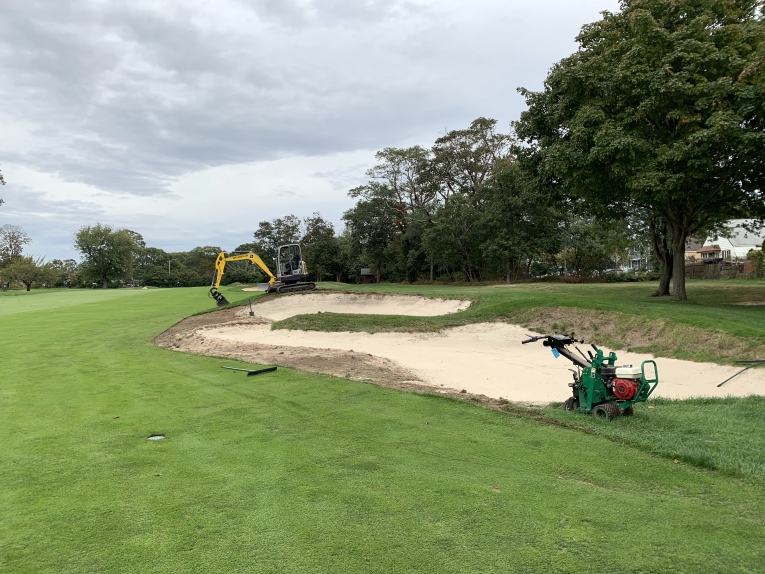
Before, the tongue that protruded into this bunker right of 8th fairway at Inwood was modern in appearance and created a disjointed bunker floor.
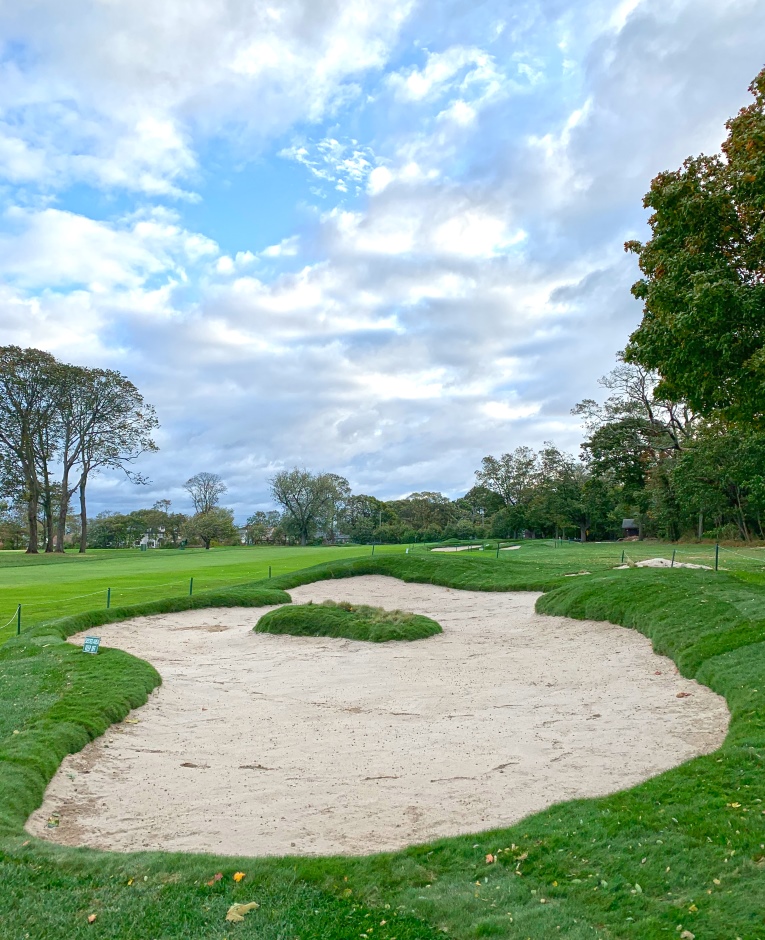
After, more sand is visible from the tee and the flat bottom bunker is in keeping with a course built in the Golden Age.
Inwood CC is blessed with some areas that drain extremely well, and the club did not find it useful or necessary to install bunker liners or additional drainage on their 8th hole. Other areas on the golf course will certainly require drainage, but in this case the project was accomplished with minimal inputs in a short amount of time.
It is also important to account how widely costs can vary based on the location of the work site, existing soils, and the club’s desire to add additional drainage, liner, or expensive sand. However, in-house projects like these can be even more affordable for clubs if they own a few pieces of key equipment (namely, a sod cutter, skid loader, mini excavator, and dump truck) and are willing to be a part of the construction process.
16. What five golf courses would you like to restore or renovate?
Militia Hill Golf Course, PA (Hurdzan/Fry) – I would like to see a more subdued presentation of the bunkering. The many high sand faces throughout the golf course seem starkly overdone and incongruous with the surrounding woodland on this beautiful property.
Bedford Golf and Tennis Club, NY (Devereux Emmet) – Some modern construction has crept its way onto this classic layout over the years. A light and creative touch could take Bedford to the next level for this low-key town club.
Metacomet, RI (Donald Ross)- This is a fun and under-the-radar Ross course just outside Providence, RI. The golf course has a fantastic set of greens and some genius half-par holes. I think it would be a blast to study and work with the Ross architecture here.
Tumblebrook, CT (Willie Park Jr.) – There probably isn’t much pure Willie Park Jr. left in the United States, but it would be incredible to bring back his architectural style at Tumblebrook.
Belleport, NY (Raynor)– They have a historical affiliation with Raynor, but only minimal evidence exists that any template principles were implemented. The setting is beautiful and the golf course has a lot of potential if the club decides to invigorate an otherwise featureless design.
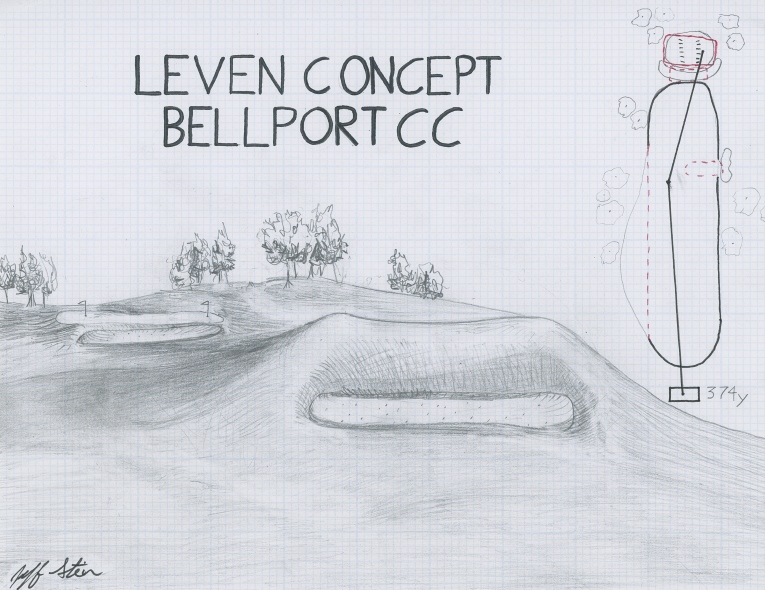
17. Suffice to say, I doubt you think Devereux Emmet gets the respect he deserves among Golden Age architects? What intrigues you about his work?
I’m most intrigued by the variety and progression of Emmet’s golf courses throughout his career. It would be an impossible task to pin Emmet to one particular style, which is something I admire in his work. Emmet produced high-quality golf courses across a variety of landscapes; from the rocky outcroppings of Bonnie Briar in Westchester to the Hempstead Plain at Rockville Links. Generally speaking Emmet employed mounding and built-up greensites to add difficulty, as well as a variety of bunkering schemes that could easily be defined as “quirky” or unusual. St. George’s, on the eastern half of Nassau County, has some of the more interesting collection of pits and trenches I have come across in his work.
We should also consider the fact that Emmet built dozens of golf courses, competing against Donald Ross, A.W. Tillinghast, Walter Travis, William Flynn, C.B. Macdonald and Seth Raynor, is doubly impressive. If you were to look at Emmet’s resume and 40-year career, there is no question he should be considered along with all the greats. There just isn’t a conversation about Golden Age architecture without Emmet being included as a central figure. While there are a few Emmett courses which have long since closed, there are still many great examples of his work, some of which have been thoughtfully restored by Gil Hanse at St. George’s Country Club, Jim Urbina at Rockville Links, and Ian Andrew at Huntington CC.
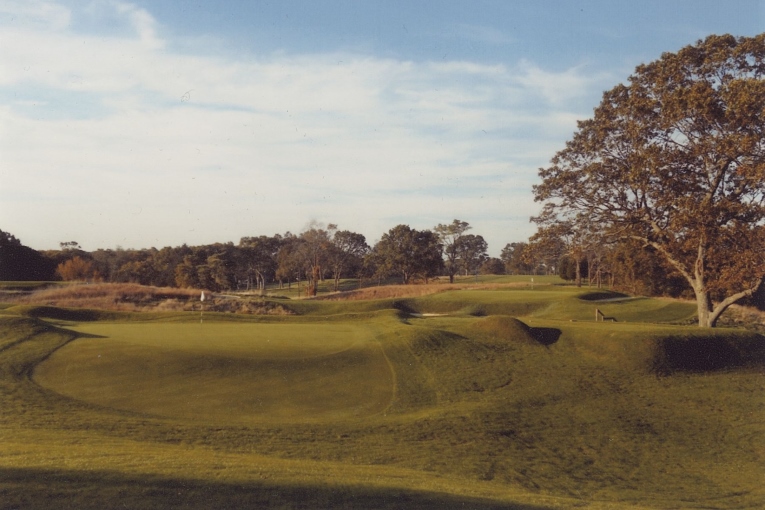
The 16th green at St. George’s is in the foreground and the evil short one shot 17th is in the distance.
Several years ago Mark Chalfant (a leading expert on Devereux Emmet) asked me to contribute an illustration to his book “Devereux Emmet’s Inspiring Architecture”, to which I happily obliged. My conversations with Mark and reading his book gave me a much greater appreciation of Emmet’s work.
No matter how we rank the great architects of the Golden Age, the fact remains Emmet was a pioneer of early American golf and is one of a handful of architects that we rightly revere for their ingenuity and advancement of the artform.
18. You don’t get to choose when you are born nor that you got into architecture when the bottom dropped out of new course construction in 2008/2009. In order to progress your career, is restoration work the best path forward?
Creative thinking is always the best path forward, and in order to be successful one has to cut one’s own path in whatever one does. While I’m hopeful to create a new design, the renovation of more modern golf courses will likely emerge as a greater opportunity to implement my ideas about golf architecture. I would still welcome the opportunity to restore some of the venerable old classics, but I believe the renovation work of the future will be just as design heavy. As golf course infrastructure ages and tastes in the market transform from the boom years, those property owners are going to take a hard look at what they have and decide if it should continue to exist in its current form. The “new” work we might see is the redevelopment of 18-hole golf courses and/or short courses with better practice facilities on existing golf properties. With the emergence of Top Golf and Drive Shack, owners are starting to look at their golf courses and are beginning to consider whether they should add one of these trendy amenities. It doesn’t work everywhere, but if we think about it, you will likely see better utilization and a reduction in overhead from a smaller course footprint with practice-type amenities that would be attractive to a broader demographic of people.
19. Hanse Design’s Cavemen recently gathered at the new Pinehurst No. 4 course. What were your impressions?
That’s right! We just finished the 5th annual Caveman Cup, an annual event graciously hosted by Gil and Jim every year. I worked only 3 weeks during the construction of course No. 4 so when I came back to play this past November I was able to put fresh eyes on the new course. I can honestly say without shading any bias that it is a blast to play and a wonderful complement to course No.2 and the rest of the resort.
Knowing Gil, he obviously realized that there was no sense in trying to outshine Ross’s masterpiece and we got a golf course with a distinctly different flavor. There are many heroic shots and even some of those challenges that I mentioned earlier, which are easier than they appear. A great example is the par-4 8th, with a crossing hazard to obscure the view to the green. To get the best angle of approach you must challenge the hazard, but risk a blind shot. The blindness is compensated with ample chipping area short and right of the green to have a chance at par.
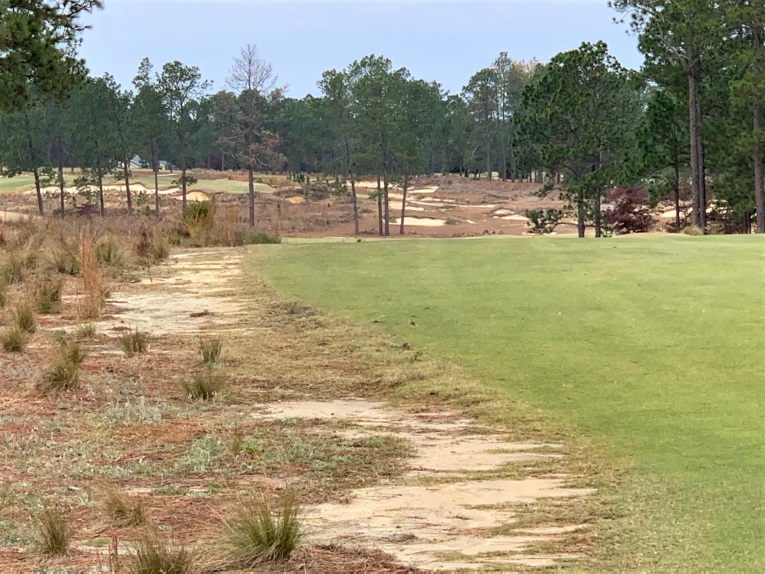
Part of the appeal of the revamped Pinehurst No. 4 is how well it rests on the ground.
The greens are fun and have a great variety to them with a mix of push ups and others more on grade. While the greens were a real challenge for a first time player and even severe in places, the real question is who wants to come to Pinehurst and putt on flat greens anyway? Hats off for a job well done.
20. Switching gears, how do clubs routinely waste money?
For my money, good design goes hand-in-hand with efficient maintenance practices and can look good too! All clubs value design aesthetics differently, but if a club were looking to trim the fat in their maintenance practices as it relates to the presentation of its design, I would certainly recommend that they focus on eliminating secondary mowing heights around the fairways and greens. Not only can clubs can save hundreds of labor hours throughout the year, but they also save on a reduction in equipment maintenance and spraying of chemicals in these secondary areas. All inputs included, a secondary cut might cost $100k throughout the year to maintain. All golf clubs should ask themselves if they really need 5 or 6 heights of cut on their golf course or if that same money would be better allocated to other high priority areas.
My job as a golf architect is to present clubs and superintendents with different options that hopefully will save them time and money while presenting really interesting golf strategies. Simplifying mowing heights around the fairways is a no brainer and easy to do. When we reduce heights of cut, we also continue to reduce visual clutter. The golf course can become more a part of the landscape rather than a mowing pattern etched into the turf.
21. Well said – ‘The golf course can become more a part of the landscape rather than a mowing pattern etched into the turf.’ In conclusion, why should a club give you, a 34 year old, a chance?
If you are looking for a talented golf architect who pays attention to detail, clubs and owners should absolutely talk to Bill Coore, Gil Hanse, Tom Doak, Jim Urbina, or Mike DeVries. Clubs should hire these guys because they are extremely talented craftsmen and have proven track records. However, if these architects are not available to your club, for whatever reason, one might consider hiring those who have worked alongside them.
As the second Golden Age of golf has played out over the last decade, I’ve spent those years working on award-winning projects like Old Macdonald, Dismal River Red and Ohoopee Match Club while collaborating with these great architects. Combined, I’ve spent thousands of hours on bulldozers and excavators, traveling to architecturally significant golf courses around the world and learning from these modern masters. I would welcome the opportunity to bring my knowledge and professional expertise to your club as well.
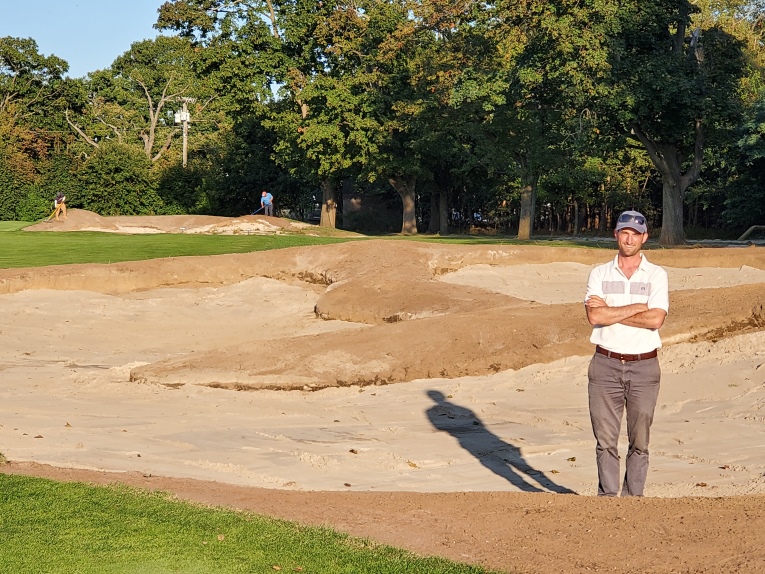
For inquiries please refer to my website www.steingolf.com and contact me directly: jeffrey@steingolf.com or follow me on instagram @steingolfdesign .
Thank you Ran!








